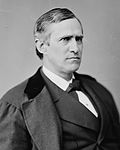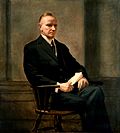| Portrait | Name | Term | Position |
|---|
 | John Langdon | April 6–21, 1789 | President pro tempore |
 | John Adams | April 21, 1789 – March 4, 1797 | President of the Senate |
 | Thomas Jefferson | March 4, 1797 – March 4, 1801 | President of the Senate |
 | Aaron Burr | March 4, 1801 – March 4, 1805 | President of the Senate |
 | George Clinton | March 4, 1805 – April 20, 1812 | President of the Senate |
 | William H. Crawford | April 20, 1812 – March 4, 1813 | President pro tempore |
 | Elbridge Gerry | March 4, 1813 – November 23, 1814 | President of the Senate |
 | John Gaillard | November 25, 1814 – March 4, 1817 | President pro tempore |
 | Daniel Tompkins | March 4, 1817 – March 4, 1825 | President of the Senate |
 | John C. Calhoun | March 4, 1825 – December 28, 1832 | President of the Senate |
 | Hugh Lawson White | December 28, 1832 – March 4, 1833 | President pro tempore |
 | Martin Van Buren | March 4, 1833 – March 4, 1837 | President of the Senate |
 | Richard Mentor Johnson | March 4, 1837 – March 4, 1841 | President of the Senate |
 | John Tyler | March 4 – April 4, 1841 | President of the Senate |
 | Samuel L. Southard | April 4, 1841 – May 31, 1842 | President pro tempore |
 | Willie P. Mangum | May 31, 1842 – March 4, 1845 | President pro tempore |
 | George M. Dallas | March 4, 1845 – March 4, 1849 | President of the Senate |
 | Millard Fillmore | March 4, 1849 – July 9, 1850 | President of the Senate |
| Vacant July 9–11, 1850 [a] |
 | William R. King | July 11, 1850 – December 20, 1852 | President pro tempore |
 | David Rice Atchison | December 20, 1852 – March 4, 1853 | President pro tempore |
 | William R. King | March 4 – April 18, 1853 | President of the Senate |
 | David Rice Atchison | April 18, 1853 – December 4, 1854 | President pro tempore |
 | Lewis Cass | December 4, 1854 | President pro tempore |
 | Jesse D. Bright | December 5, 1854 – June 9, 1856 | President pro tempore |
 | Charles E. Stuart | June 9–10, 1856 | President pro tempore |
 | Jesse D. Bright | June 11, 1856 – January 6, 1857 | President pro tempore |
 | James Murray Mason | January 6 – March 4, 1857 | President pro tempore |
 | John C. Breckinridge | March 4, 1857 – March 4, 1861 | President of the Senate |
 | Hannibal Hamlin | March 4, 1861 – March 4, 1865 | President of the Senate |
 | Andrew Johnson | March 4 – April 15, 1865 | President of the Senate |
 | Lafayette S. Foster | April 15, 1865 – March 2, 1867 | President pro tempore |
 | Benjamin Wade | March 2, 1867 – March 3, 1869 | President pro tempore |
 | Salmon P. Chase | March 13 – May 26, 1868 | Chief Justice
(Impeachment trial of Andrew Johnson) |
 | Schuyler Colfax | March 4, 1869 – March 4, 1873 | President of the Senate |
 | Henry Wilson | March 4, 1873 – November 22, 1875 | President of the Senate |
 | Thomas W. Ferry | November 22, 1875 – March 4, 1877 | President pro tempore |
 | William A. Wheeler | March 4, 1877 – March 4, 1881 | President of the Senate |
 | Chester A. Arthur | March 4 – September 19, 1881 | President of the Senate |
| Vacant September 19 – October 10, 1881 [b] |
 | Thomas F. Bayard | October 10–13, 1881 | President pro tempore |
 | David Davis III | October 13, 1881 – March 3, 1883 | President pro tempore |
 | George F. Edmunds | March 3, 1883 – March 3, 1885 | President pro tempore |
 | Thomas A. Hendricks | March 4, 1885 – November 25, 1885 | President of the Senate |
| Vacant November 25 – December 7, 1885 [c] |
 | John Sherman | December 7, 1885 – February 26, 1887 | President pro tempore |
 | John James Ingalls | February 26, 1887 – March 3, 1889 | President pro tempore |
 | Levi P. Morton | March 4, 1889 – March 4, 1893 | President of the Senate |
 | Adlai E. Stevenson I | March 4, 1893 – March 4, 1897 | President of the Senate |
 | Garret Hobart | March 4, 1897 – November 21, 1899 | President of the Senate |
 | William P. Frye | November 21, 1899 – March 4, 1901 | President pro tempore |
 | Theodore Roosevelt | March 4 – September 14, 1901 | President of the Senate |
 | William P. Frye | September 14, 1901 – March 4, 1905 | President pro tempore |
 | Charles W. Fairbanks | March 4, 1905 – March 4, 1909 | President of the Senate |
 | James S. Sherman | March 4, 1909 – October 30, 1912 | President of the Senate |
 | Augustus Octavius Bacon | October 30 – December 15, 1912 | President pro tempore
(rotating) |
 | Jacob Harold Gallinger | December 16, 1912 – January 4, 1913 | President pro tempore
(rotating) |
 | Augustus Octavius Bacon | January 5–18, 1913 | President pro tempore
(rotating) |
 | Jacob Harold Gallinger | January 19 – February 1, 1913 | President pro tempore
(rotating) |
 | Augustus Octavius Bacon | February 2–15, 1913 | President pro tempore
(rotating) |
 | Jacob Harold Gallinger | February 16 – March 4, 1913 | President pro tempore
(rotating) |
 | Thomas R. Marshall | March 4, 1913 – March 4, 1921 | President of the Senate |
 | Calvin Coolidge | March 4, 1921 – August 2, 1923 | President of the Senate |
 | Albert B. Cummins | August 2, 1923 – March 4, 1925 | President pro tempore |
 | Charles G. Dawes | March 4, 1925 – March 4, 1929 | President of the Senate |
 | Charles Curtis | March 4, 1929 – March 4, 1933 | President of the Senate |
 | John Nance Garner | March 4, 1933 – January 20, 1941 | President of the Senate |
 | Henry A. Wallace | January 20, 1941 – January 20, 1945 | President of the Senate |
 | Harry S. Truman | January 20 – April 12, 1945 | President of the Senate |
 | Kenneth McKellar | April 12, 1945 – January 4, 1947 | President pro tempore |
 | Arthur H. Vandenberg | January 4, 1947 – January 3, 1949 | President pro tempore |
 | Kenneth McKellar | January 3–20, 1949 | President pro tempore |
 | Alben W. Barkley | January 20, 1949 – January 20, 1953 | President of the Senate |
 | Richard Nixon | January 20, 1953 – January 20, 1961 | President of the Senate |
 | Lyndon B. Johnson | January 20, 1961 – November 22, 1963 | President of the Senate |
 | Carl Hayden | November 22, 1963 – January 20, 1965 | President pro tempore |
 | Hubert Humphrey | January 20, 1965 – January 20, 1969 | President of the Senate |
 | Spiro Agnew | January 20, 1969 – October 10, 1973 | President of the Senate |
 | James Eastland | October 10 – December 6, 1973 | President pro tempore |
 | Gerald Ford | December 6, 1973 – August 9, 1974 | President of the Senate |
 | James Eastland | August 9 – December 19, 1974 | President pro tempore |
 | Nelson Rockefeller | December 19, 1974 – January 20, 1977 | President of the Senate |
 | Walter Mondale | January 20, 1977 – January 20, 1981 | President of the Senate |
 | George H. W. Bush | January 20, 1981 – July 13, 1985 | President of the Senate |
 | Strom Thurmond | July 13, 1985 [d] | President pro tempore |
 | George H. W. Bush | July 13, 1985 – January 20, 1989 | President of the Senate |
 | Dan Quayle | January 20, 1989 – January 20, 1993 | President of the Senate |
 | Al Gore | January 20, 1993 – January 20, 2001 | President of the Senate |
 | William Rehnquist | January 7 – February 12, 1999 | Chief Justice
(Impeachment trial of Bill Clinton) |
 | Dick Cheney | January 20, 2001 – June 29, 2002 | President of the Senate |
 | Robert Byrd | June 29, 2002 [e] | President pro tempore |
 | Dick Cheney | June 29, 2002 – July 21, 2007 | President of the Senate |
 | Robert Byrd | July 21, 2007 [f] | President pro tempore |
 | Dick Cheney | July 21, 2007 – January 20, 2009 | President of the Senate |
 | Joe Biden | January 20, 2009 – January 20, 2017 | President of the Senate |
 | Mike Pence | January 20, 2017 – January 20, 2021 | President of the Senate |
 | John Roberts | January 16 – February 5, 2020 | Chief Justice
(First impeachment trial of Donald Trump) |
 | Kamala Harris | January 20, 2021 – November 19, 2021 | President of the Senate |
 | Patrick Leahy | November 19, 2021 [g] | President pro tempore |
 | Kamala Harris | November 19, 2021 – January 20, 2025 | President of the Senate |
 | JD Vance | January 20, 2025 – present | President of the Senate |




















































































